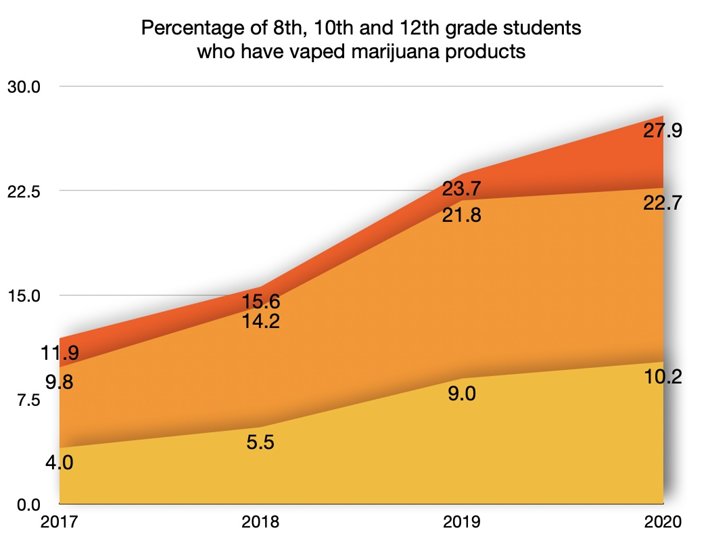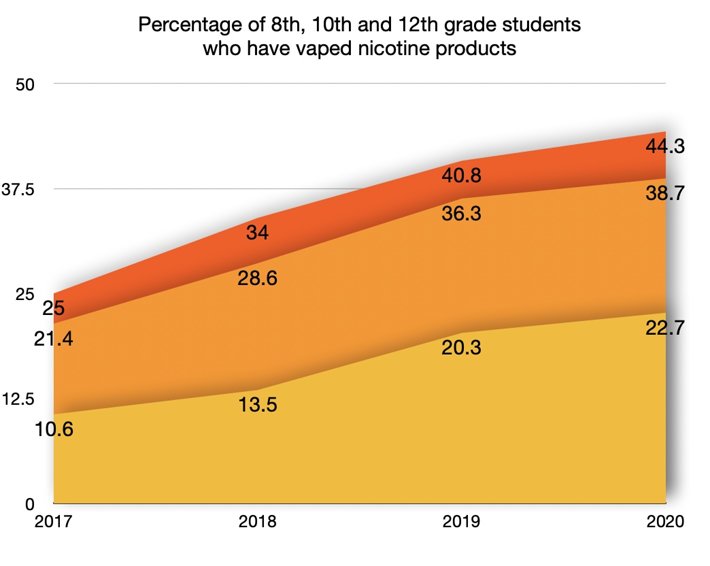Why THC Vaping Can Destroy Young Lungs

We have long known that cigarette smoking is an unhealthy habit so it should come as no surprise that we are now starting to see how unhealthy vaping is—especially vaping marijuana products.
It’s taken several years of increasing popularity to start seeing the damaging effects of drawing chemicals and addictive substances into our lungs. Now we have enough statistical and medical information to document the damage and destruction of young lungs from vaping, particularly THC vaping.
What is THC?
THC is the primary intoxicant in marijuana. As the marijuana production industry has become more and more commercialized, growers have found ways to boost the content of a single component of marijuana: Delta-9-tetrahydrocannabinol, normally abbreviated as THC.
This is the substance most sought by those who wish to consume marijuana for the purpose of getting high. The higher the THC level, the more desirable the leafy product is.
At first, vaping companies offered nicotine or flavor cartridges to those using the devices. Flavors such as chocolate, menthol, coffee or mango were offered. Before long, marijuana dispensaries and retail stores (and the black market) were offering THC cartridges to be used in these devices.
An Alarm is Sounded about Vaping Harm
In 2019, the Centers for Disease Control and Prevention began sounding the alarm about people arriving in emergency rooms across the country in respiratory distress. Patients were coughing, wheezing and having difficulty breathing. Their blood oxygen levels were abnormally low. This new health condition was named EVALI, short for e-cigarette or vaping product use-associated lung injury.
Of the thousands of people arriving in ERs, 2,807 people needed to be hospitalized for EVALI and 68 of them died. Hundreds of cases were reported in Texas and Illinois, with California, Utah, Minnesota, Indiana, Pennsylvania, New York, Massachusetts, and Florida also seeing more than 100 cases each.
The CDC began sorting through the data to warn health practitioners and the public on what was causing this problem. They reported:
- 82% of those with EVALI reported using THC products
- 33% reported ONLY using THC products
- 57% reported using nicotine products
- 14% reported ONLY using nicotine products
At this time, research is continuing to understand this new health problem, but some conclusions have been made.
Important Report from the University of Michigan
A March 2021 report from the University of Michigan provided insight on the problems caused specifically by vaping cannabis products. This report stated:
“Adolescents who vape cannabis are at greater risk for respiratory symptoms indicative of lung injury than teens who smoke cigarettes or marijuana, or vape nicotine… there is a weaker relationship between e-cigarette or cigarette use and respiratory symptoms when compared to vaping cannabis…Adolescents who reported vaping marijuana were roughly twice as likely to report ’wheezing and whistling’ in the chest than those who did not.”
This is information that every parent needs to have so they can have conversations with their children about the potential harm of vaping with either marijuana or tobacco.
Why Do Youth Like Vaping?

According to the National Youth Tobacco Survey, here are some reasons associated with teen vaping.
- They see other youth vaping
- Mass media shows vaping as a normal activity for youth
- Their parents use these products
- They vape to cope with their moods or the stress of school
- They think they might be able to lose weight
- They don’t know how to say “no”
- They are influenced by advertising
There is yet another important reason youth vape. A vaping device only gives off a slight sweet smell. A teen may be able to vape either marijuana or tobacco products without being detected by teachers or parents.
What is Happening to the Lungs of Those Who Vape?
Those suffering from EVALI-related lung damage show up to the ER with these symptoms:
- Fever
- Chills
- Vomiting
- Diarrhea
- Rapid heart rate
- Chest pain
- Cough
- Headache

The damage to their lungs must be confirmed with a chest x-ray or CT scan. These images show white, opaque areas in the lungs of a person with EVALI indicating inflamed or scarred tissue. Normal lungs show up as dark areas in these images.
Medical science has not yet unraveled all the ways that vaping harms the lungs. Doctors at Johns Hopkins Medicine believe that the heated oils used in these devices are drawn deep into the lungs where they cause inflammation. Each inhalation coats the tiny passages with chemicals in the cartridge, some of which are toxic.
Permanent scarring of the lungs—called popcorn lung—can follow this inflammation. A type of pneumonia that can result in a person coughing up blood is another possible outcome. It’s even possible for a person who vapes to suffer a collapsed lung.
So How Many Youth are Vaping Marijuana?
How many of our youth are at risk for EVALI from vaping marijuana, tobacco or flavors? One of the most consistent sources of information on youth drug use is the Monitoring the Future survey. This annual survey financed by the National Institute on Drug Abuse collects information from 8th, 10th and 12th-grade students on their drug, tobacco and alcohol use.
Before 2015, the survey did not even ask about vaping. Before 2017, there were no questions about vaping THC products. That gives you an idea of how recently vaping has become popular among our youth.
What percentage of our students have ever engaged in vaping? And how many have vaped nicotine or marijuana? In the following charts, you can quickly grasp the growth.



How to Detect Vaping by Your Teen
It’s not easy. They won’t have the skunky smell of marijuana around them. Their teeth or fingers won’t be stained. They won’t leave rolling papers, pipes or bongs around.
You can watch for the following signs:
- Your child tends to frequently step away from family events for short periods. They could head outside or to a bathroom to vape.
- Your teen normally has good dental checkups but suddenly has more cavities or gum disease than usual. Young people don’t normally develop gum disease, so this symptom in particular deserves attention.
- Look for paraphernalia. You might find items that look like USB drives, cartridges that are either empty or filled with liquid, rechargeable batteries, or items that look like pens but are open at either end.
- Changes in thirst or taste. Vaping makes people thirsty and deadens their taste buds so they may use more salt or flavorings on their food than usual.
- Coughing or chest pain.
- Mouth sores or lots of throat clearing.
- Nosebleeds.
By keeping an eye out for these symptoms of vaping, you might be able to work with your teen to head off the more serious lung damage that can result from vaping marijuana.
Sources:
- https://www.cdc.gov/mmwr/volumes/69/wr/mm6903e2.htm?s_cid=mm6903e2_w
- https://www.cdc.gov/tobacco/basic_information/e-cigarettes/severe-lung-disease.html#latest-information
- https://labblog.uofmhealth.org/rounds/vaping-marijuana-associated-more-symptoms-of-lung-damage-than-vaping-or-smoking-nicotine
- https://www.cdc.gov/tobacco/data_statistics/fact_sheets/youth_data/
tobacco_use/index.htm - https://www.lung.org/lung-health-diseases/lung-disease-lookup/evali
- https://www.hopkinsmedicine.org/health/wellness-and-prevention/what-does-vaping-do-to-your-lungs
- https://www.heart.org/en/news/2020/08/26/need-another-reason-not-to-vape-your-oral-health-is-at-risk
- https://blog.uvahealth.com/2019/06/19/teens-vaping/


 ®
®